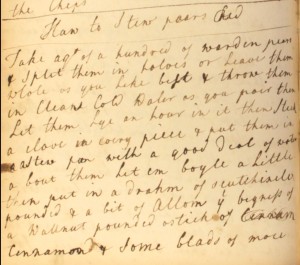After our quince pye recipe, here’s another way with autumn fruits.
This recipe specifies the use of warden pears, a common name for a varieties of firm-fleshed, sour-tasting pears, which need to be cooked before they can be eaten. The Oxford English Dictionary suggests that the name may have come from the French verb garder, ‘to keep’ and a quote from Gervase Markham’s manual on farming seems to support this theory:
Your stone-Peare, Warden-Peare, and choake-Peare [are] those which indure longest
However, others believe the name comes from the Bedfordshire village of Old Warden, where a community of monks are said to have cultivated the pears in medieval times.
Traditional varieties of cooking pear include the Black Worcester and the Catillac, but unless you’ve got these trees in your garden or have easy access to a good farmers’ market, you may need to resort to whatever you can find in the supermarket. Bosc pears are meant to be good at holding their shape but slightly under-ripe conference pears should also be a good fall-back.
How to Stew Pears Red
Take a qr of a hundred of warden pears & split them in halves or leave them whole as you like best & throw them in clean cold water as you pair them. Let them lye an hour in it, then stick a clove in every piece & put them in a stew pan with a good deal of water a bout them. Let em boyle a little, then put in a drahm of cutchinele pounded & a bit of allom ye bigness of a wallnut pounded, a stick of cinnamon & some blads of mace. Then let them boyle till very soft but take care doant brake. Take up ye pears & strain ye liquor & put in ye pears a gain & a pound of double refind sugar. Let them boyle quick till ye sirrup is very rich. Serve them hot or cold.
The red colouring for this recipe comes from pounded ‘cutchinele’ (cochineal), tiny insects from Central America. The egg yolks and dried bodies of the females yield a bright red dye, also known as carmine. If the idea of crushed cochineal bugs makes you squeamish, most supermarkets offer synthetic food colourings which would also do the trick.
The alum (‘allom’) in this recipe is a chemical compound, and it is still used today as preservative, notably in pickles. A lot of 18th century bread also included alum to keep it white and fresh. Alum powder can be bought from many Indian groceries, but the sugar content in the syrup alone should help to preserve the pears for a little while.


I’m curious to know if the ‘choake-pear’ is related to the choko – a vine fruit that is common in Sydney. It is inedible unless cooked, and leaves that sticky feeling on your hands when you peel it, unless immersed in water or peeled under a running tap. It’s rather bland like squash when cooked, but I can imagine it might benefit from being cooked in a sugar syrup…
Hi Colonial Gastronomer! Thanks so much for your thoughts about the choake pear. We’ve had a bit of a delve into some online reference sources, and disappointingly it does look like the fruits are not related…
The Oxford English Dictionary explains that the choke-pear was used to refer to any astringent pear, which was unpalatable unless cooked or turned into perry. It seems the choke refers to the harsh and rough taste and texture of it. When it comes to the choko however, the OED states that it is part of the gourd family of plants, and also explains that the name comes from a South American Indian language.
However, even if the ‘choake pear’ is not related to the choko, they definitely sound pretty similar in taste, and it would be a really interesting experiment to try the red pears recipe using choko instead!
Thank you – lovely to get a reply! I’m very inspired by your project – I work for a museum organisation in Australia, and we have a manuscript cookbook from the 1830s in our collection – author unknown – although I do have a theory as to how it arrived in the colony through some vague research clues – the mystery adds to its character!
http://blogs.hht.net.au/cook/a-curious-cookbook/
Cheers, Jacqui
Pingback: History A'la Carte 11-7-13 - Random Bits of Fascination